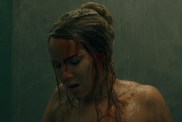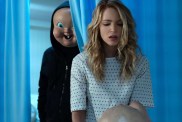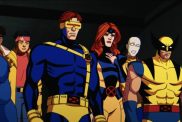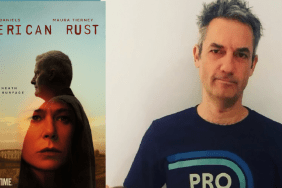
This week was FXs day of presentations to the Television Critics Association. With The Strain two weeks on the air, the entire cast of the show sat on a panel for critics, and I landed some one on ones with the big guns for Shock Till You Drop. Of course, the biggest gun is creator Guillermo del Toro – co-author of the book with Chuck Hogan and director of the pilot episode – who touches on the “vampire biology” of the series, Pacific Rim 2 and Crimson Peak.
The Strain begins when a plane lands on the tarmac with seemingly every passenger dead. A few wake up and CDC Dr. Ephraim Goodweather (Corey Stoll) cant keep them under quarantine. However, the infection continues to change them and if you havent read the book yet, heres an early spoiler warning: I ask del Toro about what happens to rock star Gabriel Bolivar (Jack Kesy). Meanwhile, Abraham Setrakian meets up with Eph and his team. Hes ready to battle the Strigoi whether the CDC is or not.
Shock Till You Drop: Youre used to realizing your own ideas. You sketch them but youre ultimately going to direct them. How did it feel to see your prose writing realized? Was the graphic novel already a step towards that?
Guillermo del Toro: It was. It was very, very strong. What happened is on the first 10 issues of The Strain in the graphic novels, Chuck and I were incredibly controlling. Do this, do that, blah blah blah. But the more David Lapham and Mike found their footing, the more you realize, my God, were in great hands. I chose David and I chose Mike because I admire them, but more and more they started going to places that I didnt see in the books. They changed things, they dropped others, added new ones. That was a real pleasure, so going in, we were looking forward to having a real partnership with Carlton. Its become a really great creative collaboration.
Shock: Had you done any illustrations for Chuck for the book? Did you sketch in your notebook for the book?
Del Toro: I had them but I had them for ages. Like, I started sketching vampire biology ideas in 1990, so theyre in my books. Actually, they are in the “Cabinet of Curiosities.” Some of the ideas that end up in The Strain are in that book.
Shock: FX can’t show the full frontal Gabriel Bolivar. If it were a movie, would you have shown the dick fall off?
Del Toro: Honestly, we actually shot every permutation of that scene. I think we did 30 versions of how he looked, with scar, no scar, triangular scar, square scar, asymmetrical scar? Sculpted it in clay, resculpted it in clay, and the version that you see is by all means the most effective way we think of telling that story.

Del Toro: Everything.
Shock: Episode four is where it really gets into the anatomy of the vampires. Did they get it all right?
Del Toro: Three is one of my favorites. Three and four I love, but the opening of three with the makeup scene is one of my favorite openings of the show. You start getting into the mythology. This is how they look. This is how they can be amongst us. They use makeup and this extensive makeup. I shot part of that scene for example. The anatomy scene, the biology scene, the autopsy, I shot part of that too because I wanted a few shots specifically to be exactly what I needed.
Shock: What were those shots?
Del Toro: One of them is the shot where you see the stinger going through the trachea and you see the movement. Another one is a closeup of him holding the tongue, a closeup of the heart. Things like that just to punctuate the scene. But I think that people will start getting the mythology, the biology and starting on five, six, seven you start getting the history of where the master comes from. Its what enriches the mythology really.
Shock: Because of the scene where one of the infected drinks the meat blood, I have to ask if you were a fan of Once Bitten with Jim Carrey?
Del Toro: You know, I never saw the entire movie but that comes from Cronos. Thats actually in my movie Cronos, same scene basically.
Shock: Have you agreed with Carlton Cuse about where each episode ends?
Del Toro: Well, what we do is Im there when we open the writers room. So, Im there when we map them out and Im there in every single script. I read them, I comment or revise them. And then Carlton and I get together and we riff on scenes that are not in the script. Then they get written or I sketch them and they get written. Its a very fluid relationship.
Shock: Do the episodes correspond to chapters from the book at all?
Del Toro: No, not really. What I find beautiful is how on TV now, you can end up in a scene that is not necessarily the biggest but it affecting. I tried to do that in the pilot. Rather than ending on an action scene, I end with the girl embracing the father and she blinks and she has the nictitating membrane of the vampires. I thought thats the most effective. You couldnt end a film like that. There is something so unique about longform TV that we are having fun with.
Shock: That blink is something I think we recognize as Guillermo del Toro. Youve experimented a lot with reversing the direction of things, like mouths and eyes are normally horizontal and you might flip em vertical.
Del Toro: Well, what I try to do is take features of what makes us human – face, eyes, teeth – and play with them. In this case, what I love is the tongue just being able to retract and then project. So, thats the most alien feature. I think what is interesting is that the more you know, the more you know that they are feeding and shitting at the same time, thats really creepy and disturbing, but feature-wise you cannot change the symmetry because we dont change the bone structure.

Del Toro: I love a name that sounds like an initial. Eph sounds like Mr. F or Mr. M. If he was called Emmett, we would say, Hey Em. I just love how it sounds. The last name Goodweather is such an ironic name for the character and the series. It just spoke to me. F Goodweather. Its like f*ck Goodweather.
Shock: Is the end of season one the end of the first book?
Del Toro: To a point it is. The thing is that we left out large portions of the first book that we would use should the series continue into a second season. It is technically the beginning and the end of the first book.
Shock: Season two wouldnt necessarily be the beginning of the second book?
Del Toro: No, in fact we pillage a little bit of the second book in the ending of the first season. I think episodes 9 and 10 contain things that are not in the first book.
Shock: The pace really picks up in episode 4 and stays ramped up in episode 5. Does the pace continue that way for the rest of the season?
Del Toro: We change a little bit. We have action episodes and then we have horror episodes and we have other episodes that are mostly character. What is interesting is that now the characters that were going separate ways start to intertwine. But even then, we dont go the normal route. For example, Gus meets Setrakian, but they dont get together for the rest of the season. Then Gus meets Zach, Ephs son, but they dont get together either. Its a little bit of a tease, and then if youre on episode 6, Fet is going to finally meet them a little later, but in the meantime theyre parallel stories. So when they start interacting, when they start summing each other, the pace picks up because youre not following separate dynamics. Youre now coming into a single story.
Shock: Which episodes do you consider the horror episodes?
Del Toro: Well, we have a bigger action one in 8. Theres a very strong horror opening on 6. There is a really, really creepy storyline with the lady lawyer that continues to develop until that story ends. I find it pure horror, but that goes through the episodes. We intercut to her a couple of times.
Shock: Is Pacific Rim 2 only happening because Legendary moved to Universal?
Del Toro: No, when we finished the first one, we said, Well, we could go here or there. At some point, Thomas [Tull] and I met and we said, You know what, it took such an effort to create the world, we would like to continue. When Legendary moved, they moved with that property. Thomas took it with him, so its a fortunate coincidence of events but we started talking about it before they made the move.

Del Toro: I have no idea. Thats complete speculation.
Shock: Are you going to go to the Kaiju world in the sequel?
Del Toro: I will not answer that. I take the fifth.
Shock: But Im asking the right questions?
Del Toro: Youre asking the right questions but not necessarily the way you think. If you think are we invading their world, were not, but were showing more of that world.
Shock: You got to make your big haunted house movie with Crimson Peak. Did you have to make any compromises to get it done?
Del Toro: No, so far everythings good. Its been one of the great experiences shooting Crimson Peak, knock on wood. Legendary saw it last week, Universal sees it this week.
Shock: Whether its Crimson Peak or The Strain, do you have to be very technical about how you shoot horror? You have to be on this mark for the lighting here to be the misdirect here?
Del Toro: Correct. Yes, especially theres a particular sequence in Crimson that Im very, very proud of. Its a killing and I use misdirection a little bit. Its all playing to what the audience thinks is going to happen and then you do something different. But I think that you can do it through a skillful staging on camera or you can do it through humor with Neil Diamond in the pilot. I guess to counterpoint and misdirect a little bit.









